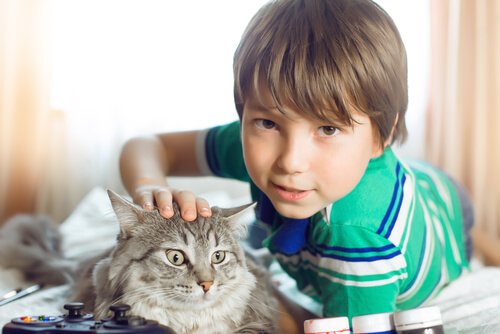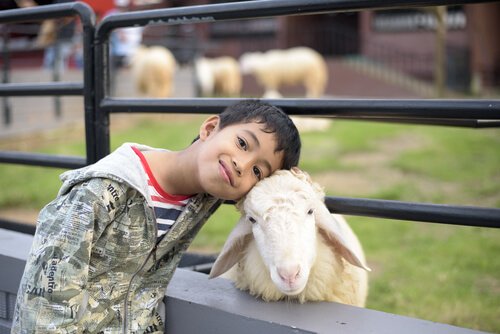Pets: Why Are Children so Attracted to Animals?

For children, their pets are wonderful friends who are always there for them with unconditional love. Those who don’t have a pet are continually asking their parents for one every time they get a chance!
Why is it that children adore animals so much? That’s the question we’re going to try to answer today!
In recent years, pet ownership has grown exponentially all around the world. In countries such as Japan, the United States and in several Latin American countries, over 50% of households have a pet dog or cat that forms part of their family.
Although it’s increasingly common to find single people with pets, many of these households are families with small children. It is in these families that you find the closest and most loving relationships with pets.
Our childhood pets remain in our memory for a lifetime. Everyone remembers the dog, cat or other pet that accompanied us during the first years of our lives.
And, aside from the world of pets, we also see that children love to visit zoos and natural parks, as well as days going fishing. What is the reason for this fascination?
“There are words that change lives, but there are barks that change the soul”
Reasons why children love animals
Each child is different, without a doubt. Because of this, each one will have their own reasons why they love a certain animal, and many of those reasons will really make us laugh!
However, there are some general reasons that create this mutual love between children and animals, and here are some of them:
More than a friend, he is a member of the family
Animals are the ideal playmate. They are always ready, always in a good mood, and never get tired. It’s quite normal for a child to consider them as even another sibling. In many cases the first word a baby pronounces is the name of his or her pet.
Accomplices and protectors
Animals often accompany us in our childhood mischief. Even though they probably don’t realize it, they’re there every time children are up to something they shouldn’t be.
Children love this unconditional affection and loyalty. It is very rare for them to react violently or to get angry. On the contrary, they will usually only do that if they see that the child is being attacked or threatened.

They make us laugh
Generally, the first sounds that babies will memorize and make are animal sounds. It may be a bark, a meow or any other animal sound, but they love imitating them and it really makes them chuckle!
Heroes and television characters
As always, television, film and other audiovisual media play an important role in shaping a child’s preferences. Animals are often “humanized” in order to tell children’s stories, just so that they can take center stage in the children’s minds.
Evaluation of different behaviors
Many things are just everyday happenings for us, but not so for children. For these little ones, who are just starting to discover the world they live in, they are amazed when they see something like a pig rolling around in the mud.
The same goes for a cow grazing, or a horse running free in the fields. They are things that just amaze them, as they haven’t seen anything like it before. And, far from scaring them, they are utterly fascinated!
Tips for choosing the right pets
Given this fascination with animals, what could be a better gift than to let them have one at home? Having a pet will provide several benefits to children, such as:
- Greater self-esteem, given the love they’ll receive from them.
- Better social skills, as they will learn to interpret feelings and needs.
- Formation of responsible habits, such as feeding, bathing and caring for them if they get sick.

The choice of pet will depend on several factors. We need to consider potential allergies to animal hair or smells, the space available at home, and how much it will cost to keep them.
We don’t really need to write about dogs and cats and their undeniable appeal. However, if it’s not possible to get one of them, we could also consider getting a rabbit, a fish or a hamster.
These are all harmless animals that are easy to care for and very playful. Of the three, rabbits are the ones that require more specific care, but they make up for that with the love they give.
Finally, we must always instill in our children the fact that having a pet is a very big responsibility. Once we choose to have a pet, we must provide them with everything they need to live a good life. And, of course, showering them with the unconditional love and affection that they give us.
For children, their pets are wonderful friends who are always there for them with unconditional love. Those who don’t have a pet are continually asking their parents for one every time they get a chance!
Why is it that children adore animals so much? That’s the question we’re going to try to answer today!
In recent years, pet ownership has grown exponentially all around the world. In countries such as Japan, the United States and in several Latin American countries, over 50% of households have a pet dog or cat that forms part of their family.
Although it’s increasingly common to find single people with pets, many of these households are families with small children. It is in these families that you find the closest and most loving relationships with pets.
Our childhood pets remain in our memory for a lifetime. Everyone remembers the dog, cat or other pet that accompanied us during the first years of our lives.
And, aside from the world of pets, we also see that children love to visit zoos and natural parks, as well as days going fishing. What is the reason for this fascination?
“There are words that change lives, but there are barks that change the soul”
Reasons why children love animals
Each child is different, without a doubt. Because of this, each one will have their own reasons why they love a certain animal, and many of those reasons will really make us laugh!
However, there are some general reasons that create this mutual love between children and animals, and here are some of them:
More than a friend, he is a member of the family
Animals are the ideal playmate. They are always ready, always in a good mood, and never get tired. It’s quite normal for a child to consider them as even another sibling. In many cases the first word a baby pronounces is the name of his or her pet.
Accomplices and protectors
Animals often accompany us in our childhood mischief. Even though they probably don’t realize it, they’re there every time children are up to something they shouldn’t be.
Children love this unconditional affection and loyalty. It is very rare for them to react violently or to get angry. On the contrary, they will usually only do that if they see that the child is being attacked or threatened.

They make us laugh
Generally, the first sounds that babies will memorize and make are animal sounds. It may be a bark, a meow or any other animal sound, but they love imitating them and it really makes them chuckle!
Heroes and television characters
As always, television, film and other audiovisual media play an important role in shaping a child’s preferences. Animals are often “humanized” in order to tell children’s stories, just so that they can take center stage in the children’s minds.
Evaluation of different behaviors
Many things are just everyday happenings for us, but not so for children. For these little ones, who are just starting to discover the world they live in, they are amazed when they see something like a pig rolling around in the mud.
The same goes for a cow grazing, or a horse running free in the fields. They are things that just amaze them, as they haven’t seen anything like it before. And, far from scaring them, they are utterly fascinated!
Tips for choosing the right pets
Given this fascination with animals, what could be a better gift than to let them have one at home? Having a pet will provide several benefits to children, such as:
- Greater self-esteem, given the love they’ll receive from them.
- Better social skills, as they will learn to interpret feelings and needs.
- Formation of responsible habits, such as feeding, bathing and caring for them if they get sick.

The choice of pet will depend on several factors. We need to consider potential allergies to animal hair or smells, the space available at home, and how much it will cost to keep them.
We don’t really need to write about dogs and cats and their undeniable appeal. However, if it’s not possible to get one of them, we could also consider getting a rabbit, a fish or a hamster.
These are all harmless animals that are easy to care for and very playful. Of the three, rabbits are the ones that require more specific care, but they make up for that with the love they give.
Finally, we must always instill in our children the fact that having a pet is a very big responsibility. Once we choose to have a pet, we must provide them with everything they need to live a good life. And, of course, showering them with the unconditional love and affection that they give us.
All cited sources were thoroughly reviewed by our team to ensure their quality, reliability, currency, and validity. The bibliography of this article was considered reliable and of academic or scientific accuracy.
- Gómez G., L. F., Atehortua H., C. G., & Orozco Padilla, S. C. (2007). La influencia de las mascotas en la vida humana. Revista Colombiana de Ciencias Pecuarias, ISSN-e 0120-0690, Vol. 20, No. 3, 2007, Págs. 377-386.
- González Jiménez, A., Márquez Hernández, V., López Rodríguez M. (2015). Educación y salud en una sociedad globalizada. Edition: 1ª, Chapter: 39. Universidad de Almería. Pp.186-192. Extraído de: https://books.google.es/books?hl=es&lr=&id=VjwwBwAAQBAJ&oi=fnd&pg=PA186&dq=amistad+mascotas+y+niños&ots=gZSP8yTJVE&sig=wQCtniVtSde2BjvJE-1BaibDLEA#v=onepage&q=amistad%20mascotas%20y%20niños&f=false
- Martínez, C. A. C., Garaviño, S. M. H., Martínez, D. I. J., & Restrepo, M. T. (2011). Estudio descriptivo de los efectos que ejerce el perro como mascota en el desarrollo de la motricidad gruesa de infantes sanos de cinco años de edad. Revista Lasallista de Investigacion.
- Taxa, J. (2012). Representaciones y vínculo entre niños y sus mascotas (MasterThesis). Pontificia Universidad Católica de Perú. Lima. Extraído de: http://tesis.pucp.edu.pe/repositorio/bitstream/handle/123456789/1701/TAXA_MARCOS_JUAN_CARLOS_REPRESENTACIONES.pdf?sequence=1&isAllowed=y
This text is provided for informational purposes only and does not replace consultation with a professional. If in doubt, consult your specialist.








